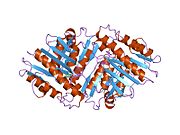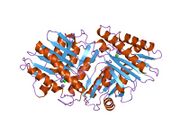Biology:Inositol monophosphatase 1
Inositol monophosphatase 1 is an enzyme that in humans is encoded by the IMPA1 gene.[1][2]
Interacting partners
IMPA1 has been shown to interact with Bergmann glial S100B[3] and calbindin.[4][5]
Chemical inhibitors
L-690,330 is a competitive inhibitor of IMPase activity with very good activity in vitro however with limited bioavailability in vivo.[6] Due to its increased specificity compared to Lithium, L-690,330 has been used extensively in characterizing the results of IMPase inhibition in various cell culture models. L-690,488, a prodrug or L-690,330, has also been developed which has greater cell permeability. Treatment of cortical slices with L-690,488 resulted in accumulation of inositol demonstrating the activity of this inhibitor in tissue.[7]
Inhibition of IMPA1 activity can have pleiotropic effects on cellular function, including altering phosphoinositide signalling,[8] autophagy, apoptosis,[9] and other effects.
Bipolar disorder
Initially it was noticed that several drugs useful in treatment of bipolar disorder such as lithium, carbamazepine and valproic acid had a common mechanism of action on enzymes in the phosphatidylinositol signalling pathway[10] and the inositol depletion hypothesis for the pathophysiology of bipolar disorder was suggested. Intensive research has so far not confirmed this hypothesis, partly because lithium can also act on a number of other enzymes in this pathway, complicating results from in vitro studies.
References
- ↑ "cDNA cloning of human and rat brain myo-inositol monophosphatase. Expression and characterization of the human recombinant enzyme". Biochem J 284 (3): 749–54. Aug 1992. doi:10.1042/bj2840749. PMID 1377913.
- ↑ "Entrez Gene: IMPA1 inositol(myo)-1(or 4)-monophosphatase 1". https://www.ncbi.nlm.nih.gov/sites/entrez?Db=gene&Cmd=ShowDetailView&TermToSearch=3612.
- ↑ "Bergmann glial S100B activates myo-inositol monophosphatase 1 and Co-localizes to purkinje cell vacuoles in SCA1 transgenic mice". Cerebellum 8 (3): 231–44. September 2009. doi:10.1007/s12311-009-0125-5. PMID 19593677.
- ↑ "Calbindin D28k targets myo-inositol monophosphatase in spines and dendrites of cerebellar Purkinje neurons". Proc. Natl. Acad. Sci. U.S.A. 102 (16): 5850–5. April 2005. doi:10.1073/pnas.0407855102. PMID 15809430. Bibcode: 2005PNAS..102.5850S.
- ↑ "Myo-inositol monophosphatase is an activated target of calbindin D28k". J. Biol. Chem. 277 (44): 41954–9. November 2002. doi:10.1074/jbc.M203492200. PMID 12176979.
- ↑ "In vitro and in vivo inhibition of inositol monophosphatase by the bisphosphonate L-690,330". J. Neurochem. 60 (2): 652–8. February 1993. doi:10.1111/j.1471-4159.1993.tb03197.x. PMID 8380439.
- ↑ "Effects of L-690,488, a prodrug of the bisphosphonate inositol monophosphatase inhibitor L-690,330, on phosphatidylinositol cycle markers". J. Pharmacol. Exp. Ther. 270 (1): 70–6. July 1994. PMID 8035344.
- ↑ "The mood stabiliser lithium suppresses PIP3 signalling in Dictyostelium and human cells". Dis Models Mech 2 (5–6): 306–12. 2009. doi:10.1242/dmm.001271. PMID 19383941.
- ↑ "Inositol and IP3 levels regulate autophagy: biology and therapeutic speculations". Autophagy 2 (2): 132–4. 2006. doi:10.4161/auto.2387. PMID 16874097.
- ↑ "A common mechanism of action for three mood-stabilizing drugs". Nature 417 (6886): 292–5. May 2002. doi:10.1038/417292a. PMID 12015604. Bibcode: 2002Natur.417..292W.
Further reading
- "Structure of inositol monophosphatase, the putative target of lithium therapy". Proc. Natl. Acad. Sci. U.S.A. 89 (21): 10031–10035. 1992. doi:10.1073/pnas.89.21.10031. PMID 1332026. Bibcode: 1992PNAS...8910031B.
- "The effects of lithium ion and other agents on the activity of myo-inositol-1-phosphatase from bovine brain". J. Biol. Chem. 255 (22): 10896–901. 1981. doi:10.1016/S0021-9258(19)70391-3. PMID 6253491.
- Bone R; Frank L; Springer JP; Pollack, Scott J.; Osborne, Sallyann; Atack, John R.; Knowles, Michael R.; McAllister, George et al. (1994). "Structural analysis of inositol monophosphatase complexes with substrates". Biochemistry 33 (32): 9460–9467. doi:10.1021/bi00198a011. PMID 8068620.
- "Structural studies of metal binding by inositol monophosphatase: evidence for two-metal ion catalysis". Biochemistry 33 (32): 9468–9476. 1994. doi:10.1021/bi00198a012. PMID 8068621.
- Ganzhorn AJ; Lepage P; Pelton PD; Strasser, Françoise; Vincendon, Pascale; Rondeau, Jean-Michel (1996). "The contribution of lysine-36 to catalysis by human myo-inositol monophosphatase". Biochemistry 35 (33): 10957–10966. doi:10.1021/bi9603837. PMID 8718889.
- "Molecular characterization of coding and untranslated regions of rat cortex lithium-sensitive myo-inositol monophosphatase cDNA". Gene 191 (1): 81–87. 1997. doi:10.1016/S0378-1119(97)00045-0. PMID 9210592.
- Sjøholt G; Molven A; Løvlie R; Wilcox, A; Sikela, JM; Steen, VM (1997). "Genomic structure and chromosomal localization of a human myo-inositol monophosphatase gene (IMPA)". Genomics 45 (1): 113–122. doi:10.1006/geno.1997.4862. PMID 9339367.
- Nemanov L; Ebstein RP; Belmaker RH; Osher, Yamima; Agam, Galila (1999). "Effect of bipolar disorder on lymphocyte inositol monophosphatase mRNA levels". The International Journal of Neuropsychopharmacology 2 (1): 25–29. doi:10.1017/S1461145799001315. PMID 11281967.
- Bahn JH; Kim AY; Jang SH; Lee, BR; Ahn, JY; Joo, HM; Kan, TC; Won, MH et al. (2002). "Production of monoclonal antibodies and immunohistochemical studies of brain myo-inositol monophosphate phosphatase". Mol. Cells 13 (1): 21–7. doi:10.1016/S1016-8478(23)14999-5. PMID 11911470.
- "Inositol monophosphatase activity in normal, Down syndrome and dementia of the Alzheimer type CSF". Neurobiol. Aging 23 (3): 389–396. 2002. doi:10.1016/S0197-4580(01)00335-9. PMID 11959401.
- "Myo-inositol monophosphatase is an activated target of calbindin D28k". J. Biol. Chem. 277 (44): 41954–41959. 2003. doi:10.1074/jbc.M203492200. PMID 12176979.
- Strausberg RL; Feingold EA; Grouse LH; Derge, JG; Klausner, RD; Collins, FS; Wagner, L; Shenmen, CM et al. (2003). "Generation and initial analysis of more than 15,000 full-length human and mouse cDNA sequences". Proc. Natl. Acad. Sci. U.S.A. 99 (26): 16899–16903. doi:10.1073/pnas.242603899. PMID 12477932. Bibcode: 2002PNAS...9916899M.
- Sjøholt G; Ebstein RP; Lie RT; Berle, J Ø; Mallet, J; Deleuze, J F; Levinson, D F; Laurent, C et al. (2005). "Examination of IMPA1 and IMPA2 genes in manic-depressive patients: association between IMPA2 promoter polymorphisms and bipolar disorder". Mol. Psychiatry 9 (6): 621–629. doi:10.1038/sj.mp.4001460. PMID 14699425.
- Gerhard DS; Wagner L; Feingold EA; Shenmen, CM; Grouse, LH; Schuler, G; Klein, SL; Old, S et al. (2004). "The status, quality, and expansion of the NIH full-length cDNA project: the Mammalian Gene Collection (MGC)". Genome Res. 14 (10B): 2121–2127. doi:10.1101/gr.2596504. PMID 15489334.
- Rual JF; Venkatesan K; Hao T; Hirozane-Kishikawa, Tomoko; Dricot, Amélie; Li, Ning; Berriz, Gabriel F.; Gibbons, Francis D. et al. (2005). "Towards a proteome-scale map of the human protein-protein interaction network". Nature 437 (7062): 1173–1178. doi:10.1038/nature04209. PMID 16189514. Bibcode: 2005Natur.437.1173R.
- Ohnishi T; Ohba H; Seo KC; Im, J.; Sato, Y.; Iwayama, Y.; Furuichi, T.; Chung, S.-K. et al. (2007). "Spatial expression patterns and biochemical properties distinguish a second myo-inositol monophosphatase IMPA2 from IMPA1". J. Biol. Chem. 282 (1): 637–646. doi:10.1074/jbc.M604474200. PMID 17068342.
External links
- PDBe-KB provides an overview of all the structure information available in the PDB for Human Inositol monophosphatase 1
 |










